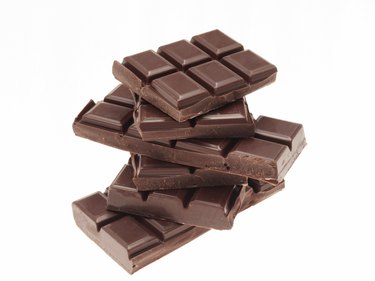
Chocolate is derived from cocoa beans and has been consumed in a variety of forms for countless generations by indigenous peoples, particularly natives of South American countries. Cocoa beans are rich sources of caffeine, which has traditionally been used to reduce fatigue, but it is also used in more modern times to alleviate certain types of headaches. Commercially made chocolate often has a high sugar content, which can be used to alleviate diabetes-related headaches.
Cocoa Bean Properties
Video of the Day
Cocoa beans are an excellent source of polyphenols, which are antioxidants that eliminate free-radicals. Free-radicals incite inflammatory reactions and cause tissue damage, especially within blood vessels, which can lead to pain and headaches. Cocoa beans also contain certain minerals and vitamins, which are needed to regulate muscle tension, carry oxygen in the blood and heal connective tissue. Further, cocoa beans are rich in caffeine, which has a variety of effects on the cardiovascular and central nervous systems.
Video of the Day
Types of Chocolate
Chocolate is generally divided into three varieties: dark, milk and white. The main difference between the types is the percentage of cocoa powder. Dark chocolate usually contains between 50 and 80 percent cocoa powder, which makes it a rich source of caffeine, according to "Contemporary Nutrition." Milk chocolate generally contains much less than 50 percent cocoa powder, but much more refined sugar, which accounts for its sweeter taste. White chocolate is mainly sugar and dairy products and often contains no cocoa powder or natural caffeine.
Migraine Headaches
Migraine headaches have complex and poorly understood causes, but widely fluctuating blood vessel diameters within the head lead to most of the symptoms, as stated in "The Mechanism and Management of Headache." Initially, due to a variety of causal factors, the blood vessels that supply certain parts of the brain constrict, or become too small, which can cause strange visual phenomena to occur, called auras. Shortly thereafter, the body overcompensates by dramatically dilating the same blood vessels, which causes pressure and pounding head pain that can last for hours. Caffeine interferes with the actions of adenosine, a brain neurotransmitter that promotes vasodilation and blood flow in the brain and throughout the body. Consequently, caffeine can cause vasoconstriction and reduce blood flow to the head by up to 30 percent, and abort or reduce the painful stages of most migraine headaches, according to "Human Biochemistry and Disease." Obviously, dark chocolate with its high percentage of cocoa powder would be best type to combat these headaches.
Hypoglycemic Headaches
Hypoglycemic headaches occur when the blood sugar is too low. Lack of food or high dosages of insulin are common causes of these headaches, which are usually dull and achy in nature, as cited in "Comprehensive Review of Headache Medicine." Eating milk or white chocolate, which have high glycemic indexes due to their refined sugar content, can quickly increase glucose levels in the bloodstream and temporarily alleviate this type of headache.
Withdrawal Headaches
Consumption of caffeine and highly refined sugar lead to physical dependency. Eating too much chocolate over many days or weeks can cause addiction, which leads to withdrawal symptoms after discontinued use. Ironically, the main withdrawal symptom for both caffeine and sugar is debilitating, migraine-like headaches. Thus, chocolate in moderation can temporarily alleviate some headaches, but overdose and withdrawal can lead to ones that may be more painful.